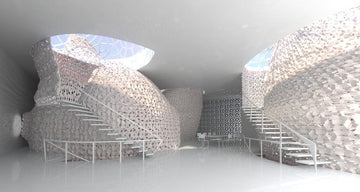The Rise of 3D Printed Wearables
Wearable technology has evolved from basic fitness trackers to encompass a wide range of smart devices that can be worn as accessories, clothing, or even integrated into the human body. The advent of 3D printing has brought unprecedented possibilities to this field. Here's how 3D printed wearables are revolutionizing fashion and functionality:Customization: One of the most significant advantages of 3D printed wearables is the ability to customize designs to an individual's unique body shape and style preferences. This personalization ensures a perfect fit and allows wearers to express their individuality.
Complex Geometry: 3D printing allows designers to create intricate and complex geometries that would be impossible to achieve through traditional manufacturing methods. This freedom in design leads to innovative and visually stunning wearables.
Integration of Electronics: 3D printed wearables can seamlessly integrate electronics, sensors, and other functional elements directly into the design. This enables features like LED lighting, temperature control, health monitoring, and even augmented reality (AR) experiences.
Sustainability: With growing concerns about the environmental impact of the fashion industry, 3D printing offers a more sustainable alternative. It minimizes material waste by only using what is necessary for the design, and it can use recycled or biodegradable materials.
Examples of 3D Printed Wearables
Let's delve into some fascinating examples of 3D printed wearables that highlight the convergence of fashion and technology:Custom-Fit Footwear: Companies like Adidas and Nike are using 3D printing to create customized shoe soles tailored to an individual's foot shape and walking style. This not only enhances comfort but also improves athletic performance.
Smart Glasses: 3D printed smart glasses are more lightweight and comfortable, offering features like AR displays, gesture controls, and even prescription lenses. These glasses seamlessly blend fashion and technology.
Biometric Jewelry: Jewelry pieces like rings or bracelets can now incorporate biometric sensors to monitor vital signs and health metrics. They offer both functional benefits and aesthetic appeal.
Fashion Forward Prosthetics: 3D printing has revolutionized the design of prosthetic limbs, making them not only functional but also stylish. Amputees can choose from a variety of designs and colors to match their personal style.
The Future of 3D Printed Wearables
As technology continues to advance, the future of 3D printed wearables looks incredibly promising. We can anticipate:Advanced Materials: The development of new materials, such as conductive and shape-shifting ones, will enable even more innovative and functional wearables.
Mass Customization: The fashion industry may shift towards mass customization, with consumers able to design and print their own clothing and accessories at home.
Health and Wellness: Wearables will increasingly focus on health and wellness, with integrated sensors and AI-powered analytics providing real-time health insights and assistance.
Sustainability: 3D printing will play a crucial role in the fashion industry's sustainability efforts by reducing waste and enabling more eco-friendly materials.






